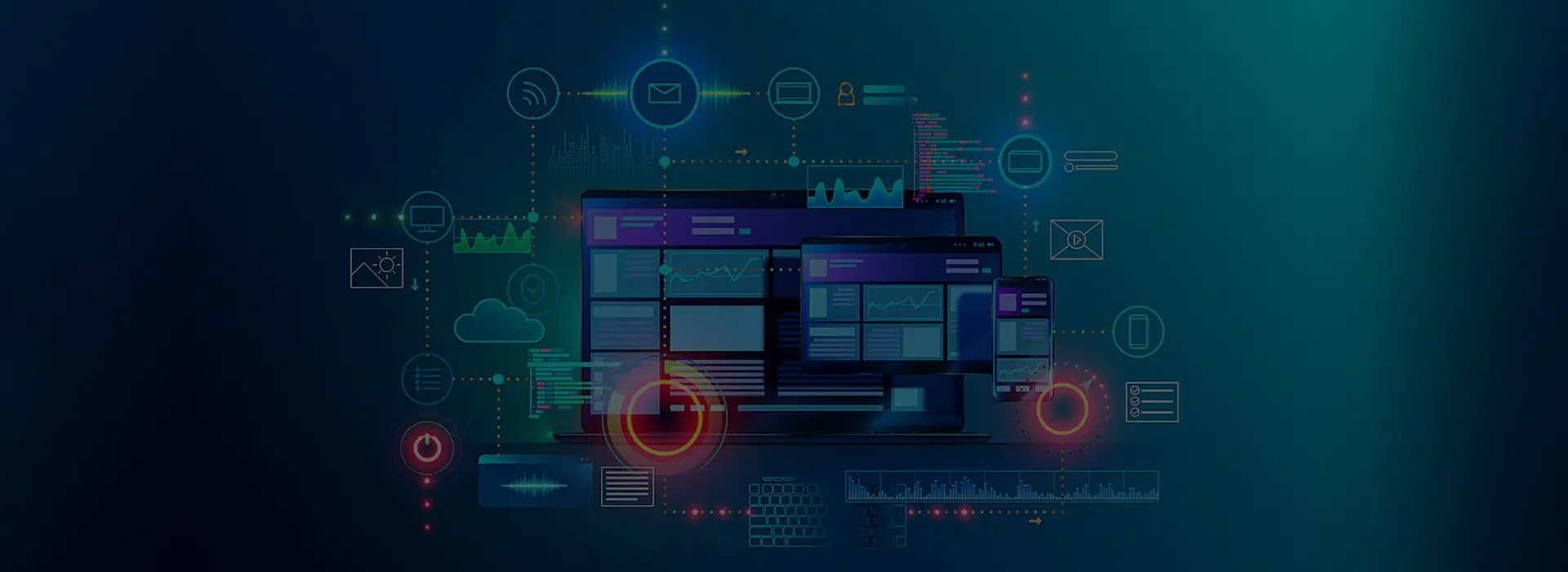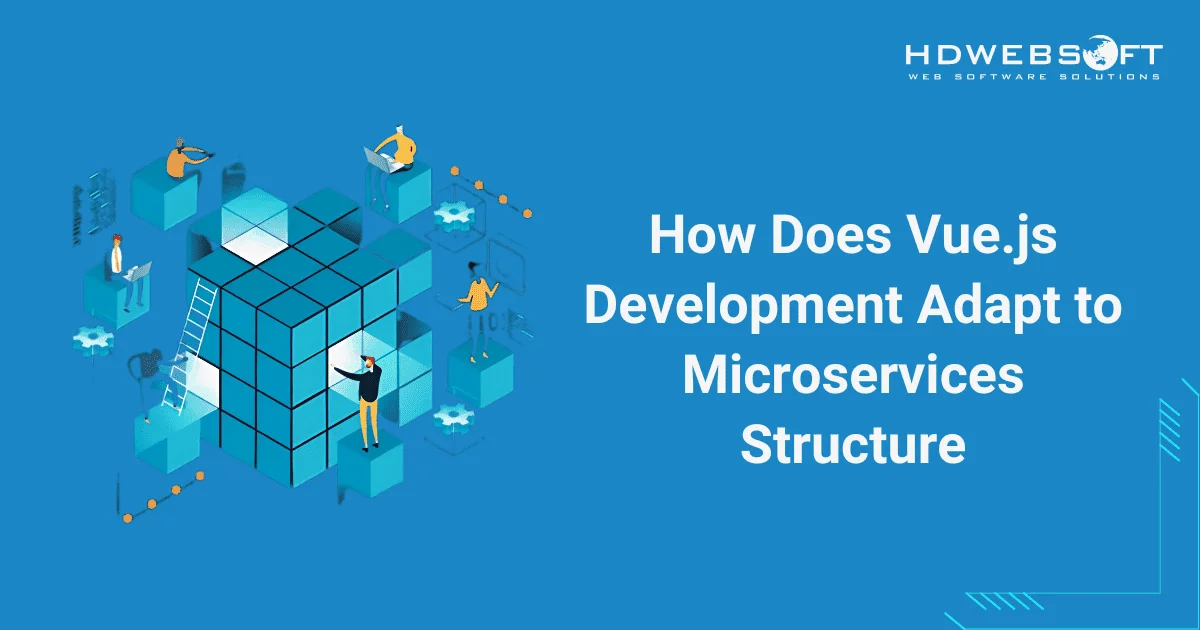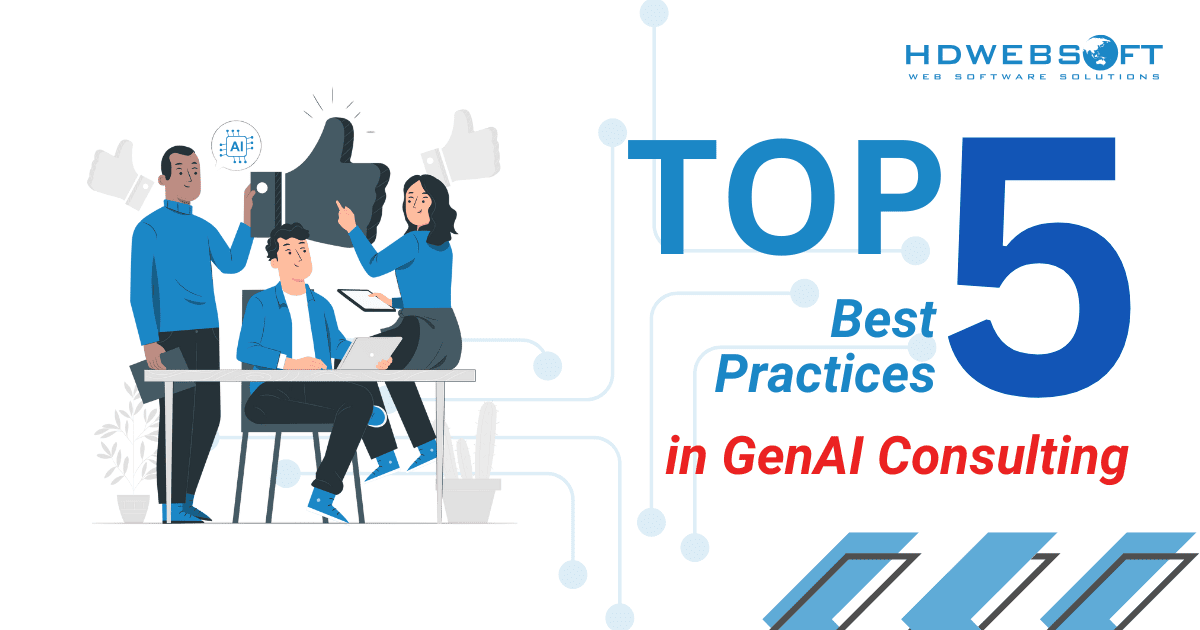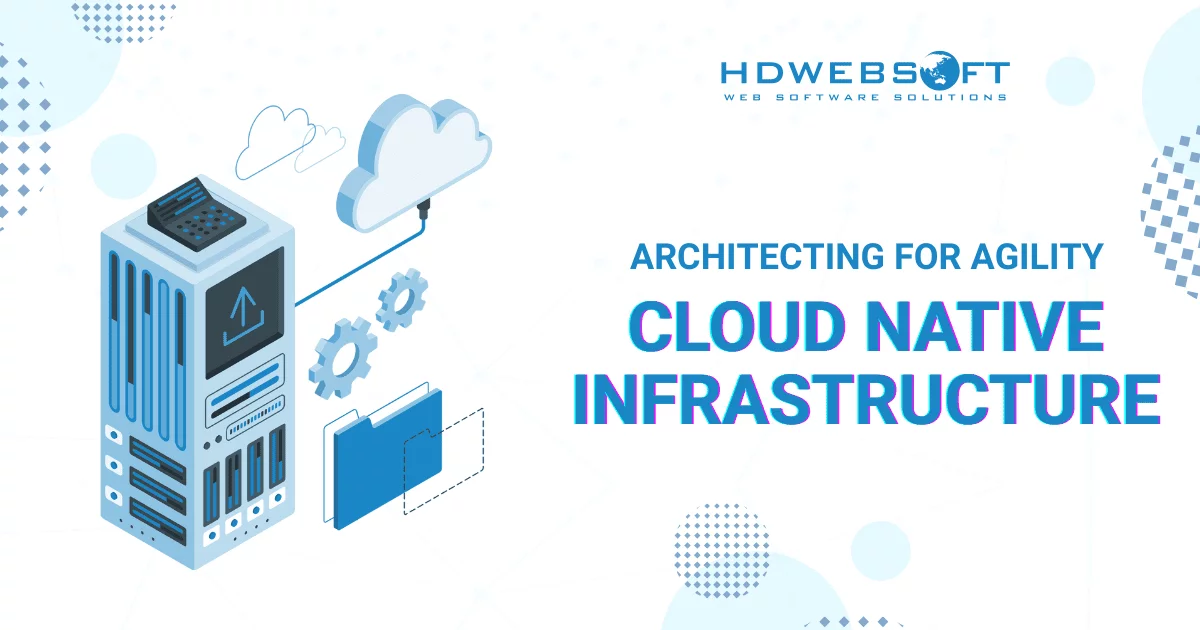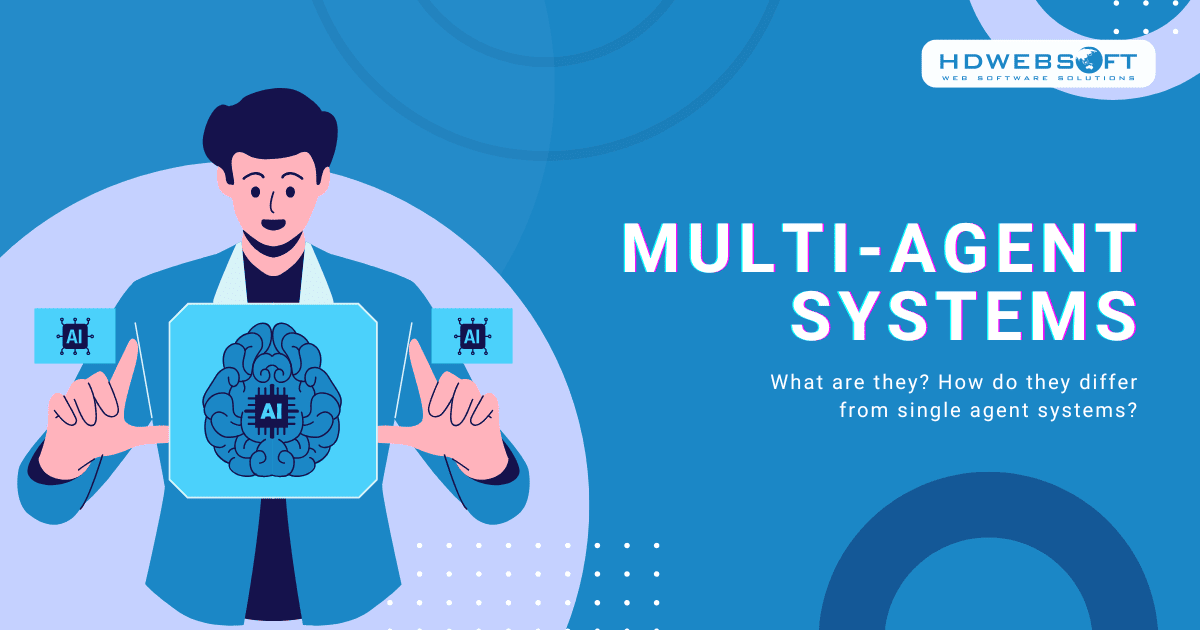
What are Multi-Agent Systems (MAS)?
Multi-agent systems have emerged as a key advancement in artificial intelligence development, driven by the growing demand for complex interactions and automated decision-making in dynamic, multidimensional environments. In recent years, AI has evolved rapidly, from basic, single-function tools to sophisticated, intelligent ecosystems. As we move into 2025, MAS stands at the forefront of this transformation. It’s offering a more scalable, flexible, and collaborative alternative to traditional monolithic AI models.
In today’s article, we’ll dive into the definition, the types, its benefits, and practical applications.
- 1) What is a Multi-Agent System?
- 2) The Difference Between Multi-Agent and Single-Agent Systems
- 3) Types of Multi-Agent Systems
- 4) MAS Development Lifecycle
- 5) Communication Protocols for Multi-agent Systems
- 6) Multi Agent System Development Learning Methods
- 7) Performance Optimization Techniques
- 8) Benefits of Multi-Agent Systems
- 9) Practical Applications of Multi-Agent Systems
- 10) Practical Getting Started Guide for Multi-Agent Systems
- 11) Premier MAS Solutions Supplier in Vietnam
What is a Multi-Agent System?
At its core, multi-agent systems are made up of several specialized AI agents that collaborate to complete tasks that would be too complex or inefficient for a single agent to manage alone. Instead of relying on a single, all-encompassing model, this approach assigns specific roles to individual agents. Consequently, it allows each to focus on a particular function within the system.
How multi-agent systems work
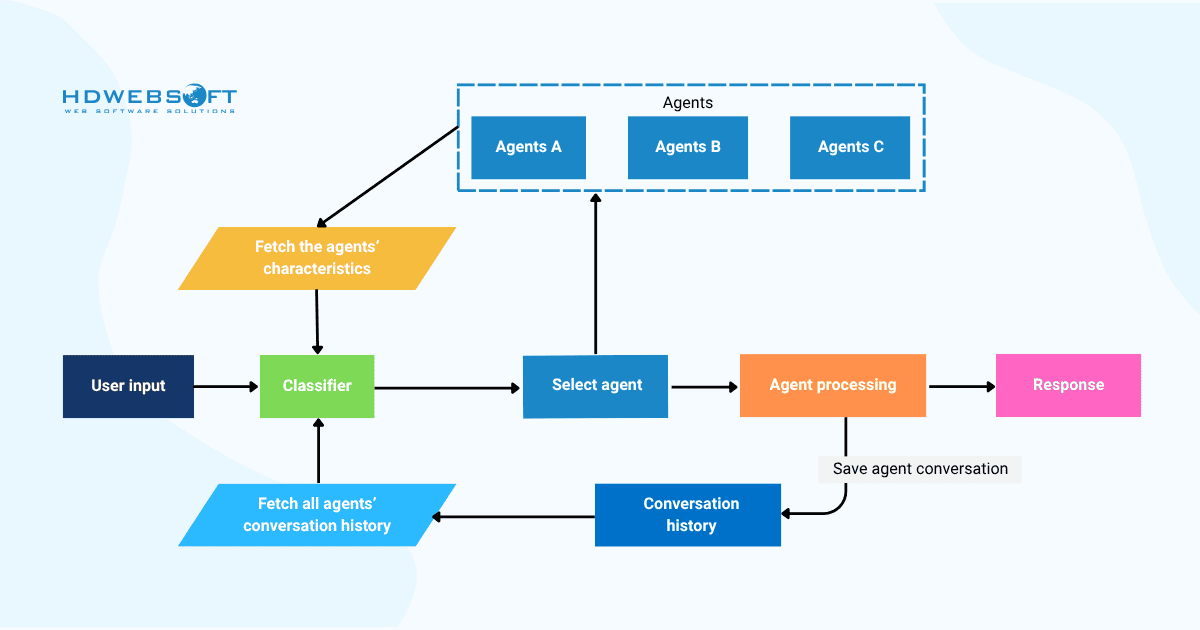
The process begins when a user submits input. A classifier analyzes the message and fetches each agent’s characteristics and past conversation history. Based on this information, the system selects the most suitable agent from a pool of specialized agents, each designed to handle specific types of tasks. The chosen agent then processes the input and generates an appropriate response. After the interaction, the conversation is stored to refine future agent selection and maintain context.
As you can see, this architecture ensures that tasks are distributed effectively, improving both performance and scalability. Rather than relying on a single, all-encompassing AI, multi-agent systems enable collaboration between targeted agents. Each of them plays a defined role in the system.
Roles and Coordination Within a Multi-Agent System
In an MAS, each agent is assigned a specialized role based on a distinct area of expertise. For example:
- System architects focus on designing overall frameworks and assessing various technical strategies.
- Technical leads are responsible for coding and managing implementation-level details.
- Documentation specialists produce clear instructions and user-facing materials.
- Data analysts work on processing and making sense of large or complex datasets.
- Support agents take care of customer interactions and troubleshoot user issues.
To ensure smooth collaboration, these agents interact through agent integration and interoperability, using a centralized coordination mechanism commonly overseen by an orchestrator or agent manager. This component handles task delegation and ensures that each request is routed to the most suitable agent. Hence, during the multi agent system development, it is able to operate efficiently and effectively.
The Difference Between Multi-Agent and Single-Agent Systems
In contrast to multi-agent systems, a single-agent system (SAS) consists of one autonomous AI agent that performs tasks based on the data it gathers from its environment. It acts independently, making decisions and executing actions without support from other agents. While effective for straightforward, isolated tasks, SAS may struggle with complex, multifaceted problems.
Both SAS and MAS are evolving areas in artificial intelligence. However, the distinction between them can be unclear, especially for those new to the field.
In order to clarify their key differences, we’ve provided you with the table below:

In summary, a multi-agent system offers significant advantages over a single-agent system in terms of scalability, adaptability, and resilience. Their ability to handle distributed tasks efficiently makes them the preferred choice for complex, high-demand applications.
Types of Multi-Agent Systems
The classification of multi-agent systems depends primarily on how individual agents interact, organize, and coordinate their activities within complex environments.
Currently, the AI agents market is expected to approach $220.9 billion by 2035 with a remarkable 36.55% CAGR. Hence, understanding these fundamental system types becomes increasingly crucial for successful implementation across diverse applications.
Cooperative Agents
Cooperative multi-agent systems represent the most collaborative approach, where all agents share common objectives and work synergistically toward unified goals. These systems excel in scenarios requiring collective problem-solving, such as distributed computing networks or coordinated robotics applications. Furthermore, cooperative agents actively share information, resources, and computational capabilities to optimize overall system performance.
In manufacturing environments, cooperative agents coordinate production schedules, manage inventory levels, and ensure quality control across multiple assembly lines. The strength of these systems lies in their ability to eliminate redundant efforts while maximizing collective efficiency. Consequently, organizations implementing cooperative multi-agent systems often report significant improvements in operational productivity and resource utilization.
Adversarial Agents
Conversely, adversarial systems feature agents with fundamentally opposing objectives, creating competitive environments where individual success often comes at others’ expense. Financial trading platforms exemplify this approach, where algorithmic agents compete for market advantages while operating within the same ecosystem. These systems drive innovation through competition, forcing agents to improve their strategies and capabilities continuously.

Game-theoretic principles govern adversarial interactions, ensuring strategic decision-making while maintaining system stability. Moreover, adversarial frameworks prove invaluable for testing system robustness and identifying potential vulnerabilities before deployment in critical applications.
Mixed-Agent Systems
These environments, however, combine both cooperative and competitive elements, creating dynamic ecosystems where alliances shift based on situational demands. Supply chain management represents an excellent example, where companies compete for market share while collaborating on logistics and resource sharing. These systems require sophisticated negotiation protocols and adaptive strategies to effectively balance competing interests.
Additionally, mixed multi-agent systems more accurately mirror real-world scenarios than purely cooperative or adversarial approaches. They enable agents to form temporary coalitions and engage in strategic partnerships, allowing for more dynamic collaboration. Plus, agents can adjust their behavior based on shifting environmental conditions and evolving stakeholder relationships.
Hierarchical Agents
Next, hierarchical MAS establishes clear command structures with distinct authority levels and reporting relationships. Top-tier agents make strategic decisions and delegate operational tasks to subordinate agents, creating efficient management chains. Similarly, military command systems and corporate organizational structures inspire these architectures, emphasizing clear accountability and streamlined decision-making processes.
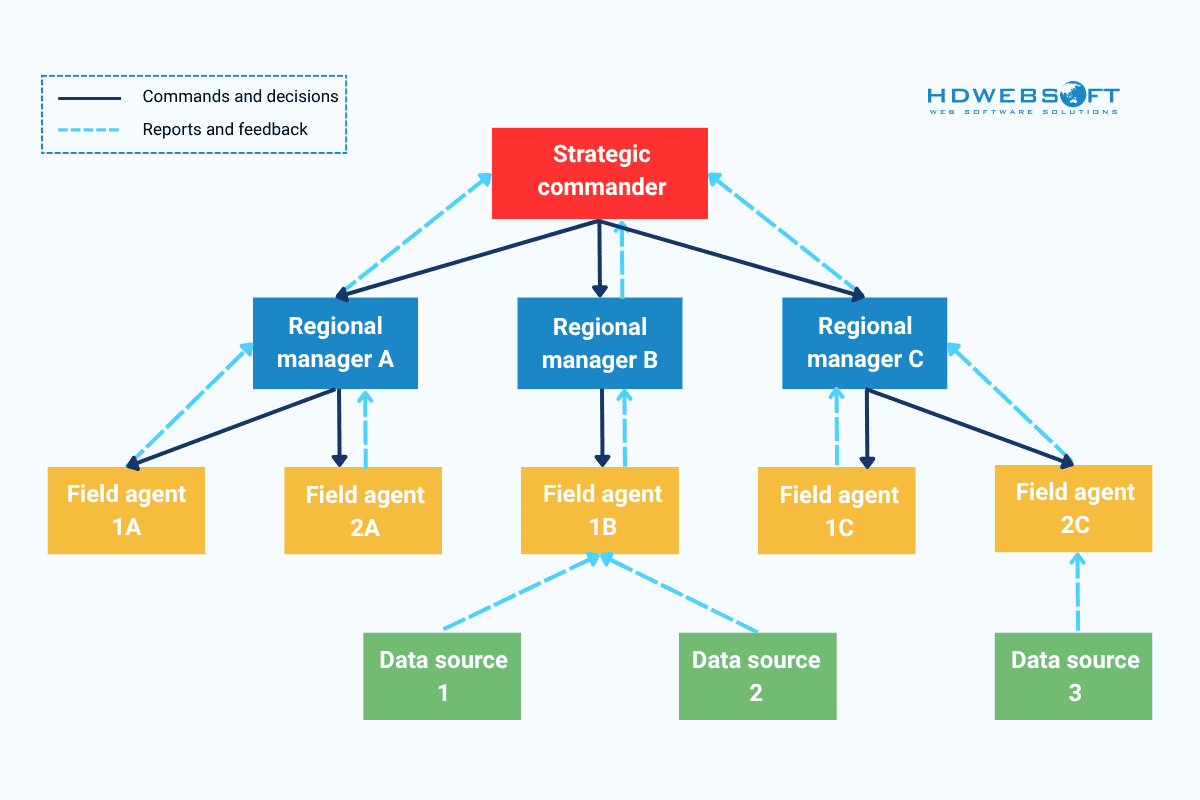
These systems excel in complex environments requiring coordinated responses across multiple operational levels. However, they must balance centralized control with local autonomy to maintain responsiveness while ensuring strategic alignment throughout the hierarchy.
Heterogeneous Agents
Finally, heterogeneous systems incorporate agents with diverse capabilities, knowledge domains, and operational characteristics. Smart city implementations demonstrate this approach effectively. They combine traffic management agents, energy distribution systems, emergency response coordinators, and citizen service platforms within unified frameworks. So, each agent type contributes specialized expertise while interacting seamlessly with other system components.
The diversity within heterogeneous multi-agent systems yields robust and adaptable solutions that can effectively handle complex, multifaceted challenges. Nevertheless, successful implementation requires sophisticated integration protocols and standardized communication interfaces. The ultimate goal is to ensure effective collaboration across different agent types and operational domains.
MAS Development Lifecycle
Creating a robust multi agent system development involves following a structured development approach that ensures all components integrate seamlessly. This comprehensive lifecycle methodology guides teams through each critical phase, from initial concept to production deployment.

Planning Phase
Initially, the planning phase establishes the foundation for your entire MAS project by defining clear objectives and system requirements. Development teams must identify the specific problems that agents will solve and determine the number and types of agents needed. Moreover, establishing communication protocols between different system components is a must.
During this stage, architects analyze existing infrastructure to understand integration points and potential constraints. Furthermore, they evaluate computational resources, data availability, and performance expectations to create realistic project timelines for developing multi-agent systems. Strategic planning also involves selecting appropriate development frameworks and defining success metrics for the multi agent system development process.
Design Phase
Subsequently, the design phase transforms planning decisions into concrete technical specifications that guide implementation efforts. System architects create detailed blueprints showing how individual agents interact, share information, and coordinate their activities within the broader ecosystem.
Comprehensive design documentation includes agent behavior models, communication schemas, and data flow diagrams that illustrate system operations. Additionally, designers specify security requirements, error handling procedures, and scalability considerations that will influence long-term system performance. This phase also establishes the overall multi agent system development architecture, including coordination mechanisms and resource allocation strategies.
Development Phase
Meanwhile, the development phase brings design concepts to life through actual coding and system construction activities. Developers create individual agent modules, implement communication protocols, and build coordination mechanisms that enable collaborative behavior across the entire system.
Throughout the development of multi-agent systems, teams follow iterative approaches that allow for continuous testing and refinement of agent behaviors. Moreover, developers integrate monitoring tools and logging mechanisms that provide visibility into agent interactions and system performance metrics. Quality assurance processes ensure that each component meets specified requirements before integration with other MAS elements.
Testing Phase
Conversely, the testing phase validates system functionality through a comprehensive evaluation of individual agents and their collective behavior. Testing methodologies include unit testing for individual agent functions, integration testing for agent interactions, and system-wide performance testing under various load conditions.
Advanced testing scenarios simulate real-world conditions, including network failures, resource constraints, and unexpected input variations that challenge system resilience. Plus, testing teams evaluate security measures, data integrity protocols, and recovery procedures that protect the MAS development from potential vulnerabilities.
Deployment Phase
Finally, the deployment phase transitions the completed system from development environments to production infrastructure, where it serves actual business needs. Deployment strategies for multi-agent systems include phased rollouts, blue-green deployments, and canary releases that minimize risks during the transition process.
Production deployment requires careful monitoring of system performance, agent behavior, and resource utilization to ensure optimal operation. Therefore, deployment teams establish maintenance procedures, update mechanisms, and backup strategies that support long-term multi agent system development success.
Communication Protocols for Multi-agent Systems
Effective multi-agent communication protocols serve as the backbone of any successful multi agent system development. They enable seamless information exchange and coordination between distributed agents. These protocols define how agents discover each other, establish connections, and maintain ongoing communication throughout their operational lifecycle.
FIPA Standards
Notably, the Foundation for Intelligent Physical Agents (FIPA) standards provide internationally recognized frameworks for MAS communication and interoperability. These standards define message formats, interaction protocols, and agent management systems that ensure compatibility across different platforms and implementations.
FIPA Agent Communication Language (ACL) specifies message structures that enable multi-agent systems to express intentions, share knowledge, and negotiate agreements effectively. Additionally, FIPA standards include ontology definitions that provide common vocabularies for domain-specific communication. Ultimately, they reduce ambiguity and improve understanding between agents.
Message Passing Mechanisms
Similarly, message passing mechanisms facilitate direct communication between agents through structured data exchange protocols. These systems support both synchronous and asynchronous communication patterns. Thus, they allow multi agent system development to coordinate activities while maintaining operational independence.
In addition, advanced message passing implementations include priority queuing, message routing, and delivery confirmation systems. In fact, they are the one that ensures reliable communication even in challenging network conditions. Moreover, these mechanisms support broadcast communication, enabling agents to share information with multiple recipients simultaneously within the MAS.
Negotiation Algorithms
Furthermore, negotiation algorithms enable agents to reach agreements on resource allocation, task distribution, and collaborative strategies through automated bargaining processes. These algorithms implement game-theoretic principles that help multi-agent systems find mutually beneficial solutions while pursuing individual objectives.
Sophisticated negotiation protocols include multi-round bidding systems, coalition formation algorithms, and conflict resolution mechanisms that handle disagreements between agents. Consequently, these algorithms enable dynamic adaptation to changing conditions and requirements within the multi agent system development environment.
Multi Agent System Development Learning Methods
Advanced learning capabilities distinguish modern MAS from static rule-based systems by enabling continuous improvement and adaptation to changing conditions. These learning methodologies allow agents to refine their behavior based on experience and feedback from their environment and interactions with other agents.
Reinforcement Learning Applications
Particularly, reinforcement learning enables agents to improve their decision-making through trial-and-error interactions with their environment. Agents receive rewards or penalties based on their actions, gradually learning optimal strategies that maximize long-term performance within their ecosystem.
Multi-agent systems’ reinforcement learning presents unique challenges, including non-stationary environments where other agents’ behaviors continuously evolve. Additionally, agents must balance exploration of new strategies with exploitation of known successful approaches. All the while, they consider the impact of their actions on other muti agent system development components.
Distributed Learning Strategies
Alternatively, distributed learning strategies enable agents to share knowledge and experiences across the multi-agent system without centralizing all learning processes. These approaches include federated learning techniques that preserve privacy while enabling collective knowledge improvement.
Notably, distributed learning implementations support both horizontal and vertical knowledge sharing. They are where agents contribute specialized expertise to improve overall system performance.
Moreover, these strategies include consensus mechanisms that help agents agree on shared knowledge. Meanwhile, they help maintain individual learning capabilities within the multi agent system development framework.
Knowledge Sharing Protocols
Additionally, knowledge sharing protocols define how multi-agent systems exchange learned information, best practices, and domain expertise to accelerate collective learning processes. These protocols include knowledge representation standards, transfer learning mechanisms, and collaborative filtering approaches that improve agent performance.
Effective knowledge sharing requires careful consideration of information quality, relevance, and timeliness to ensure that shared knowledge benefits recipient agents. In addition, these protocols include validation mechanisms that verify knowledge accuracy before integration into agent decision-making processes.
Performance Optimization Techniques
Optimizing multi agent system development performance requires systematic approaches. They should be able to address computational efficiency, communication overhead, and resource utilization across distributed agent networks. These techniques ensure that systems scale effectively while maintaining responsiveness and reliability under varying operational conditions.
Resource Allocation Strategies
Specifically, resource allocation strategies distribute computational resources, memory, and network bandwidth among agents based on current needs and priorities. Dynamic allocation mechanisms adjust resource distribution in real-time, responding to changing workloads and system demands within the multi-agent systems’ environment.
It’s worth noting that advanced allocation algorithms consider agent specializations, task complexities, and communication requirements when making resource decisions. Subsequently, these strategies include load-balancing mechanisms that prevent resource bottlenecks and ensure optimal utilization across the entire MAS infrastructure.
Communication Optimization
Meanwhile, communication optimization reduces message overhead and latency through intelligent routing, compression, and caching strategies. These optimizations minimize network traffic while ensuring that critical information reaches intended recipients promptly and reliably.
And the optimization techniques? They include two main techniques. The first one is message aggregation, where multiple small messages combine into larger batches. The second is selective communication protocols that reduce unnecessary information exchange.
Consequently, these approaches implement quality-of-service mechanisms that prioritize critical communications within the multi agent system development environment.
Scalability Enhancements
Lastly, scalability enhancements enable multi-agent systems to accommodate growing numbers of agents and increasing computational demands without degrading performance. These enhancements include horizontal scaling strategies, distributed coordination mechanisms, and hierarchical organization structures that manage complexity effectively.
Successful scalability implementations support elastic resource provisioning, automatic load distribution, and fault-tolerant architectures that maintain system availability during scaling operations. Consequently, these enhancements ensure that MAS solutions continue delivering value as organizational needs and operational requirements evolve over time.
Benefits of Multi-Agent Systems
The multi-agent approach brings several notable advantages when compared to traditional monolithic systems:
Deep Specialization
MAS enables each agent to focus on a specific area of expertise. Much like how teams benefit from role-specific professionals, this model leverages specialized agents to deliver more effective and accurate outcomes.
Efficient Resource Use
One of the most practical benefits of multi-agent design is smarter resource allocation. These systems match tasks with the right level of computing power:
- Simple tasks are handled by lightweight models that require minimal processing and token use
- More complex challenges activate advanced models only when needed.
This approach leads to better overall efficiency across the multi-agent systems. Here’s a table of real-world comparisons for resource usage:
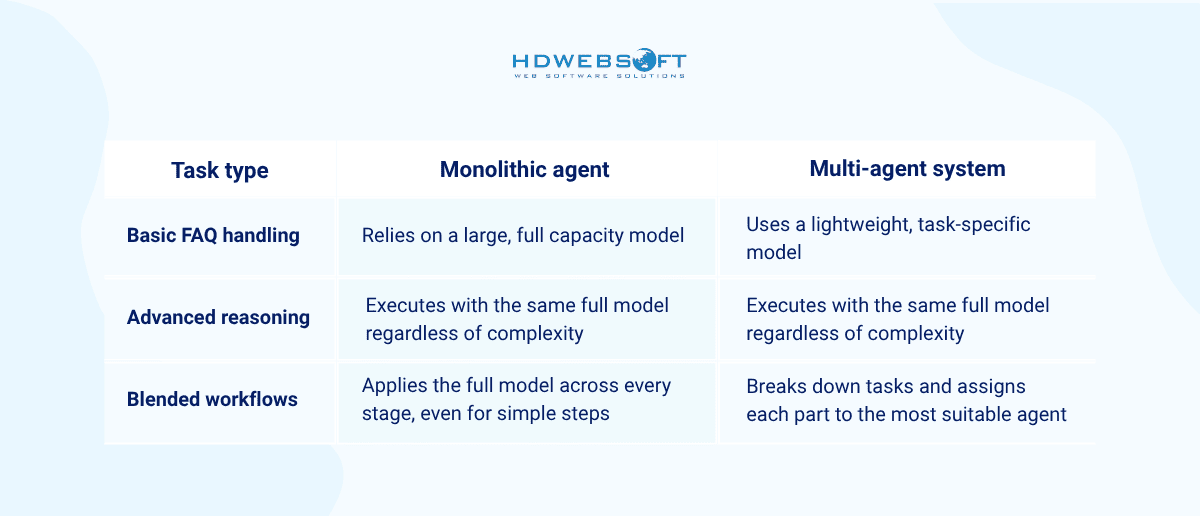
Greater System Reliability
Thanks to their distributed design, MAS is more resilient. If one agent encounters an error or fails, others can continue operating normally, minimizing disruption, an essential feature for high-stakes environments.
Easier Expansion and Innovation
New features can be introduced without retraining the entire system. Instead, you can simply plug in a new agent with a defined specialty. Thus, this modular structure supports faster updates and flexible development cycles.
Collaborative Intelligence
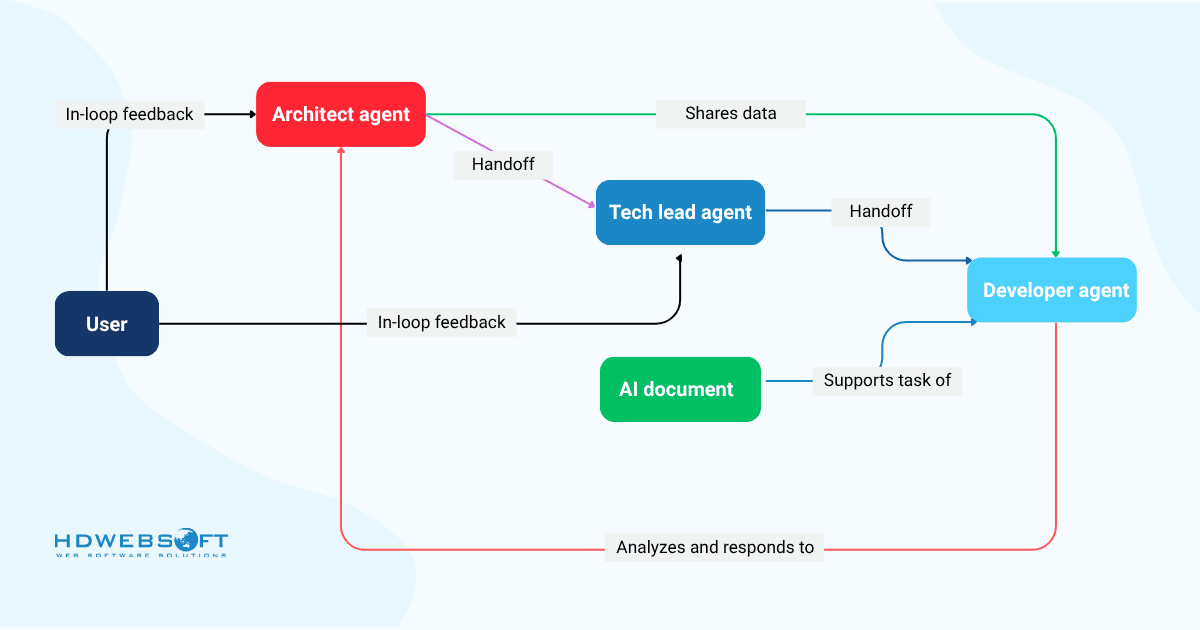
These systems mimic human collaboration, assigning different tasks to agents with complementary skills. This teamwork-based model often achieves better results than relying on a single, all-encompassing system to solve every problem alone.
Practical Applications of Multi-Agent Systems
Nowadays, MAS are increasingly adopted across diverse industries thanks to their capabilities in interaction, autonomous decision-making, and adaptive learning. Some notable use cases include:
- Energy Sector: Multi-agent systems play a critical role in smart grid management. Namely, they assist in balancing power distribution, coordinating diverse energy sources, and forecasting consumption. By analyzing real-time data, agents optimize renewable energy usage and enhance grid stability, reducing the risk of outages.
- Disaster Response: In emergency scenarios, autonomous agents collaborate to map damaged zones, identify survivors, and deliver aid. Their ability to share information in real time speeds up search operations, lowers operational risks, and improves overall rescue effectiveness.
- Manufacturing: MAS streamlines industrial workflows by overseeing tasks like quality assurance, assembly, and packaging. This leads to higher efficiency, fewer mistakes, and better product standards. In large-scale operations, such as automotive production, MAS is a driving force behind automation and increased output. For organizations looking to implement agentic process automation, MAS provides the intelligent coordination needed for next-generation workflows.
Practical Getting Started Guide for Multi-Agent Systems
Embarking on a MAS implementation journey requires careful preparation and strategic planning to ensure successful outcomes. This section provides actionable steps and frameworks that help organizations transition from traditional AI solutions to sophisticated multi-agent systems architectures effectively.
MAS Readiness Assessment Checklist
Before initiating any multi agent system development project, organizations must evaluate their current capabilities and infrastructure readiness. This assessment ensures that all prerequisites are in place for successful implementation and adoption.
Technical Infrastructure
- Existing cloud computing capabilities and scalability requirements.
- Current data management systems and integration possibilities.
- Network bandwidth and latency considerations for distributed agents.
- Security frameworks and compliance requirements are already in place.
- Monitoring and logging infrastructure for system observability.
- Development and testing environment availability.
Organizational Readiness
- Executive leadership commitment and budget allocation for multi-agent system development projects.
- Technical team expertise in AI, machine learning, and distributed systems.
- Change management processes for technology adoption and user training.
- Clear business objectives and success metrics for implementing multi-agent systems.
- Stakeholder alignment across departments that will interact with the system.
- Risk tolerance and appetite for innovative technology adoption.
Data and Process Readiness
- Data quality, availability, and accessibility across different system components.
- Existing process documentation and workflow mapping capabilities.
- Integration requirements with legacy systems and third-party applications.
- Compliance and regulatory considerations specific to your industry vertical.
- Backup and disaster recovery procedures for mission-critical operations.
- Performance benchmarks and current system limitations that need addressing.
Technology Stack Recommendations
Selecting appropriate technologies forms the foundation of successful multi agent system development initiatives. These recommendations cover essential components across different layers of the technology stack.
Development Frameworks
- JADE (Java Agent Development Framework) for enterprise-grade MAS solutions.
- Mesa for Python-based agent modeling and simulation environments
- SPADE (Smart Python Agent Development Environment) for rapid prototyping.
- Akka for JVM-based actor systems with distributed computing capabilities.
- Ray for scalable distributed AI and machine learning workloads.
- Microsoft Bot Framework for conversational agent development and deployment.
Communication and Messaging
- Apache Kafka for high-throughput message streaming between multi-agent systems’ components.
- RabbitMQ for reliable message queuing and routing protocols.
- gRPC for efficient inter-agent communication with protocol buffer support.
- WebSocket connections for real-time bidirectional communication channels.
- RESTful APIs for standardized HTTP-based agent interactions.
- Message Pack for efficient binary serialization of agent communications.
Infrastructure and Deployment
- Docker containers for consistent multi-agent system deployment across environments.
- Kubernetes orchestration for scalable and resilient agent cluster management.
- AWS/Azure/GCP cloud platforms with auto-scaling and load balancing capabilities.
- Redis for fast in-memory data storage and caching between agents.
- MongoDB or PostgreSQL for persistent data storage and agent state management.
- Prometheus and Grafana for comprehensive system monitoring and visualization.
Team Structure Requirements
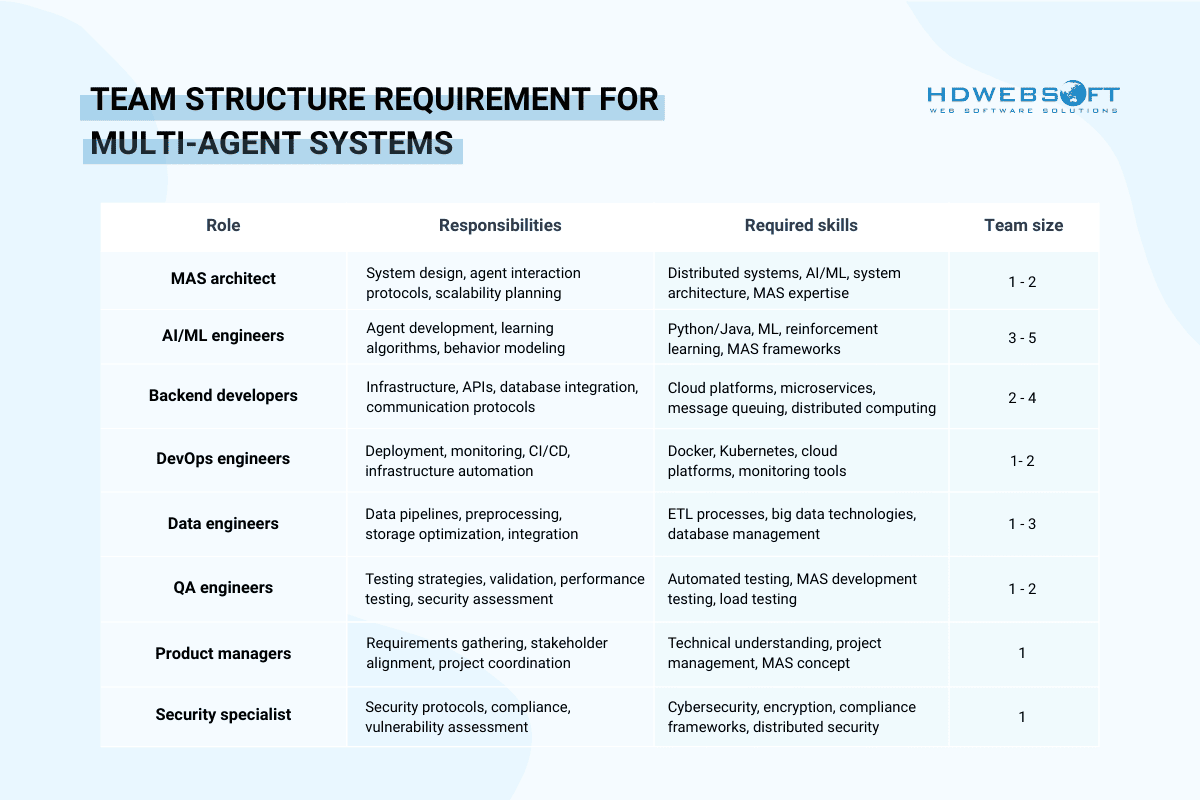
Budget Planning Guidelines
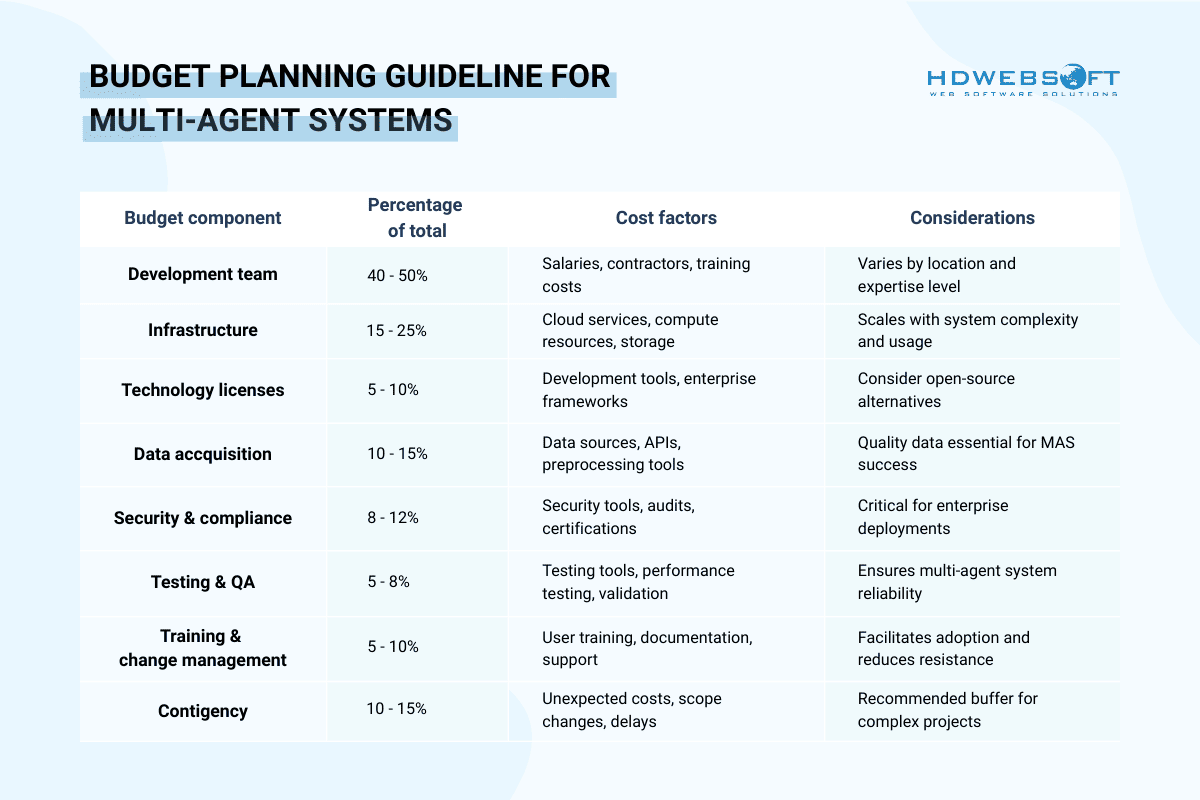
Cost Optimization Strategies
- Start with proof-of-concept implementations to validate approaches before full-scale development.
- Leverage open-source frameworks and tools where possible to reduce licensing costs.
- Consider hybrid cloud strategies to optimize infrastructure costs based on usage patterns.
- Implement phased rollouts to spread costs over time and validate ROI incrementally for multi-agent systems.
ROI Measurement Frameworks
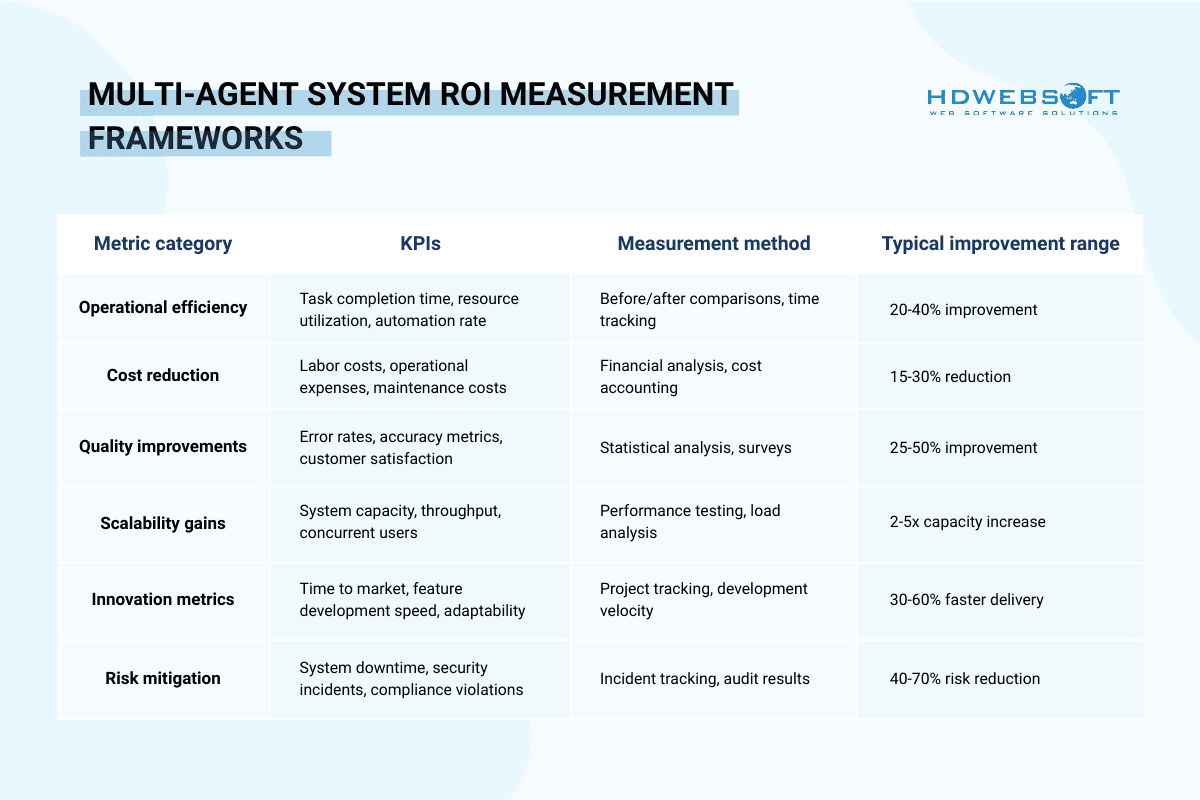
ROI Calculation Framework
- Baseline Establishment: Document current performance metrics before multi-agent system development implementation
- Cost Tracking: Monitor all implementation and operational costs throughout the project lifecycle
- Benefit Quantification: Measure improvements in efficiency, quality, and capability after deployment
- Time-based Analysis: Track ROI progression over 6, 12, and 24-month periods post-implementation
- Intangible Benefits: Consider strategic advantages like improved agility, innovation capacity, and competitive positioning
Success Measurement Timeline
- 3 months: Initial system stability and basic functionality validation
- 6 months: Operational efficiency improvements and cost reduction evidence
- 12 months: Full ROI realization and scalability benefits demonstration
- 18+ months: Strategic value delivery and competitive advantage establishment
Premier MAS Solutions Supplier in Vietnam
For enterprises seeking expert implementation of these sophisticated multi-agent systems, HDWEBSOFT stands as Vietnam’s premier technology partner. With years of specialized AI development experience and more than 250 in-house engineers, our company delivers cutting-edge solutions that transform complex business challenges into streamlined, intelligent operations across diverse industries. Contact us today for a free consultation!


